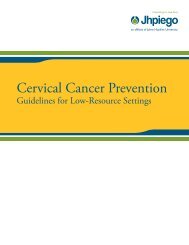Manual for Male Circumcision under Local Anaesthesia
Manual for Male Circumcision under Local Anaesthesia
Manual for Male Circumcision under Local Anaesthesia
Create successful ePaper yourself
Turn your PDF publications into a flip-book with our unique Google optimized e-Paper software.
<strong>Male</strong> circumcision <strong>under</strong> local anaesthesia<br />
Version 3.1 (Dec09)<br />
• adverse reaction to the anaesthetic used during the circumcision.<br />
These complications are rare when circumcision is per<strong>for</strong>med by well<br />
trained, adequately equipped, experienced health care personnel, and<br />
are usually easily and rapidly resolved. Data from controlled trials<br />
show that fewer than 1 in 50 procedures result in complications. 4, 6<br />
MALE CIRCUMCISION AND HIV INFECTION<br />
There is currently great interest in the role of male circumcision in<br />
preventing HIV infection. Research studies have shown a lower risk of<br />
infection in circumcised compared with uncircumcised men, as well as<br />
a lower prevalence of HIV infection in populations where male<br />
circumcision is common. These data led WHO and UNAIDS to<br />
recommend that male circumcision be promoted as an additional<br />
method of HIV prevention and that countries or settings with<br />
generalized HIV epidemics and low prevalence of circumcision should<br />
urgently scale up circumcision services. 12<br />
The evidence linking male circumcision and HIV<br />
A systematic review and meta-analysis of 28 published studies found<br />
that uncircumcised men are 2–3 times more likely to be infected with<br />
HIV than circumcised men, with the difference being most pronounced<br />
in men with high exposure to HIV infection. 5 A sub-analysis of 10<br />
African studies, involving men considered to be at high risk of<br />
becoming infected, found a 3.4 times higher incidence of HIV infection<br />
among those who had not been circumcised. 5 In a prospective study<br />
in Uganda of HIV-negative men whose partners were HIV-positive,<br />
none of 50 circumcised men became infected within two years,<br />
compared with 40 of 137 uncircumcised men. 13<br />
<strong>Male</strong> circumcision and regional differences in HIV prevalence<br />
The geographical regions in sub-Saharan Africa where men are more<br />
commonly circumcised overlap with areas of lower HIV prevalence. An<br />
extensive study by the Joint United Nations Programme on HIV/AIDS<br />
(UNAIDS) investigated behavioural and other factors that could<br />
account <strong>for</strong> the large disparities in HIV prevalence across different<br />
African regions. 14 A low prevalence of male circumcision and a high<br />
prevalence of genital herpes (which is more common in uncircumcised<br />
men) emerged as the principal determinants of the differences in HIV<br />
rates.<br />
Table 1.1 shows the prevalence of HIV infection in a number of<br />
countries with low or high rates of male circumcision. Countries in sub-<br />
Saharan Africa where male circumcision is common (>80%) generally<br />
have HIV prevalence levels well below those of countries where<br />
circumcision is less common (
















